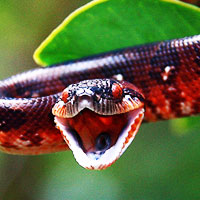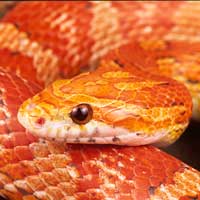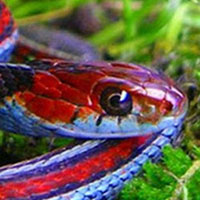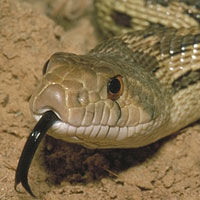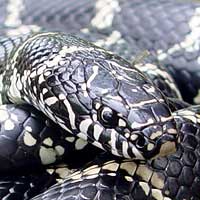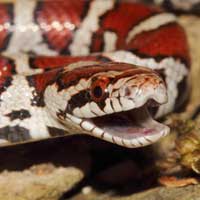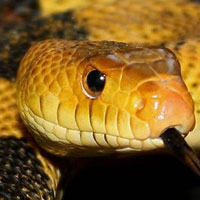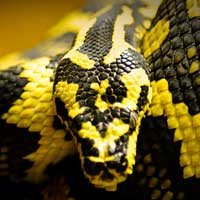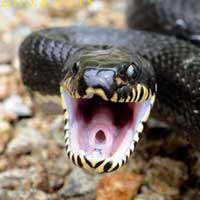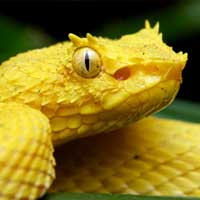Durango Mountain Kingsnake: Everything You Need to Know
The scientific name of the Durango Mountain Kingsnake is Lampropeltis mexicana. It belongs to the Colubridae family, which is the largest family of snakes and includes many non-venomous and mildly venomous species.
Scientific Name: Lampropeltis mexicana
Snake Family: Colubridae
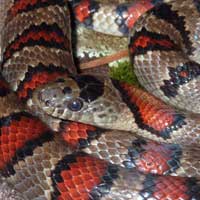
Introduction to the Durango Mountain Kingsnake
The Durango Mountain Kingsnake (Lampropeltis mexicana) is a non-venomous, brightly colored snake native to the mountainous regions of Mexico. With its striking red, black, and white bands, it resembles the venomous coral snake, which helps deter predators. Known for its manageable size and calm demeanor, the Durango Mountain Kingsnake is a popular choice among reptile enthusiasts.
Where Does the Durango Mountain Kingsnake Live?
The Durango Mountain Kingsnake is found in the mountainous and rocky regions of northern and central Mexico, particularly in the state of Durango. Its preference for cooler, high-altitude environments sets it apart from other kingsnake species.
Preferred Habitat Features:
- Rocky outcrops and slopes
- Pine-oak forests
- Grasslands with scattered shrubs
- Riparian zones near streams
| Region | Habitat Type | Key Features |
|---|---|---|
| Durango, Mexico | Rocky mountains | High elevation, cool temperatures |
| Central Mexico | Pine-oak forests | Shaded areas, abundant ground cover |
What Does the Durango Mountain Kingsnake Eat?
The Durango Mountain Kingsnake is a carnivorous predator with a diet that reflects its opportunistic feeding habits. In the wild, it preys on a variety of small animals.
Common Diet:
- Small rodents such as mice
- Lizards
- Birds and their eggs
- Occasionally other snakes
In captivity, feeding pre-killed or frozen-thawed rodents is recommended. Juveniles typically eat once every 5-7 days, while adults require feeding every 10-14 days.
Behavior and Temperament of the Durango Mountain Kingsnake
The Durango Mountain Kingsnake is known for its docile nature and active behavior. While it may be shy at first, it generally adapts well to handling and captivity.
Key Behavioral Traits:
- Non-aggressive and calm
- Active during the day and early evening
- May mimic venomous snakes when threatened
- Highly curious and exploratory in nature
With consistent handling, these snakes become more accustomed to human interaction, making them an excellent choice for both beginners and experienced keepers.
Health and Lifespan of the Durango Mountain Kingsnake
Durango Mountain Kingsnakes are hardy and long-lived when properly cared for in captivity. They can live up to 20 years with proper husbandry and diet.
Common Health Concerns:
- Respiratory infections caused by improper humidity
- Shedding issues due to low humidity
- Parasites, especially in wild-caught specimens
Maintain an enclosure with a temperature gradient of 75-85°F and provide fresh water for drinking and soaking. Regular check-ups with a reptile veterinarian are recommended to ensure long-term health.
Reproductive Traits of the Durango Mountain Kingsnake
The Durango Mountain Kingsnake is oviparous, laying eggs after mating. Breeding typically occurs in the spring, followed by egg-laying in early summer.
Reproductive Details:
- Mating season: Spring
- Clutch size: 5-12 eggs
- Incubation period: 60-70 days
- Hatchlings are independent and self-sufficient at birth
In captivity, successful breeding requires simulating natural temperature cycles and providing a suitable nesting area. Eggs should be incubated at 82-85°F for optimal hatching.
How to Handle and Care for the Durango Mountain Kingsnake
Caring for the Durango Mountain Kingsnake involves creating an environment that mimics its natural habitat and providing consistent, gentle handling.
Handling and Care Tips:
- Handle gently to reduce stress and build trust
- Provide an enclosure with hiding spots and climbing branches
- Maintain proper humidity and temperature levels
- Offer a varied diet to meet their nutritional needs
With the right care and attention, the Durango Mountain Kingsnake can thrive in captivity, offering years of fascination and companionship to its keeper.
Other Snakes In This Species
 Albino California Kingsnake
Albino California Kingsnake Arizona Mountain Kingsnake
Arizona Mountain Kingsnake Black Kingsnake
Black Kingsnake Brooks Kingsnake
Brooks Kingsnake California Kingsnake
California Kingsnake Desert Kingsnake
Desert Kingsnake Dot-Dash California Kingsnake
Dot-Dash California Kingsnake Durango Mountain Kingsnake
Durango Mountain Kingsnake Eastern Kingsnake
Eastern Kingsnake Florida Kingsnake
Florida Kingsnake Florida Mole Kingsnake
Florida Mole Kingsnake Goins Kingsnake
Goins Kingsnake Gray Banded Kingsnake
Gray Banded Kingsnake Mexican Black Kingsnake
Mexican Black Kingsnake Mole Kingsnake
Mole Kingsnake Prairie Kingsnake
Prairie Kingsnake Ruthvens Kingsnake
Ruthvens Kingsnake Scarlet Kingsnake
Scarlet Kingsnake Speckled Kingsnake
Speckled Kingsnake Utah Mountain Kingsnake
Utah Mountain Kingsnake Variable Kingsnake
Variable Kingsnake
